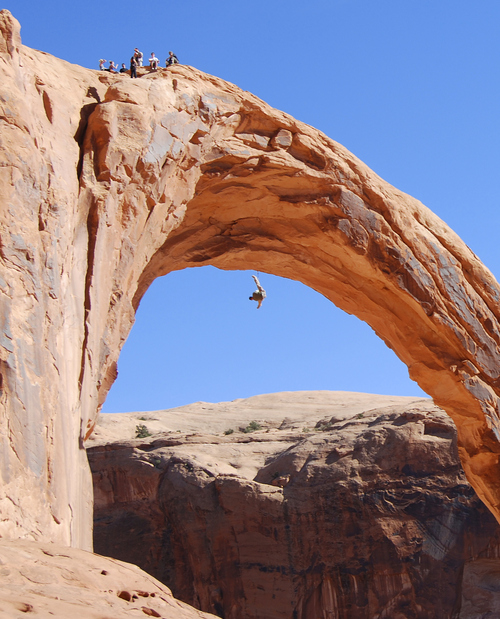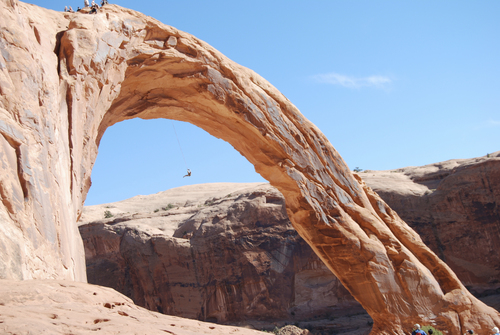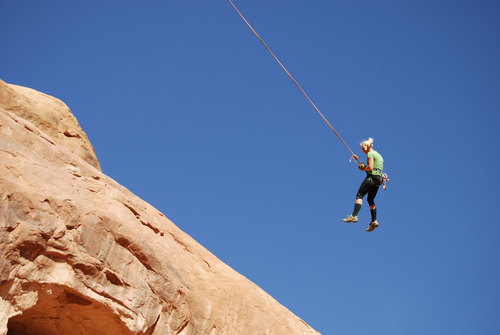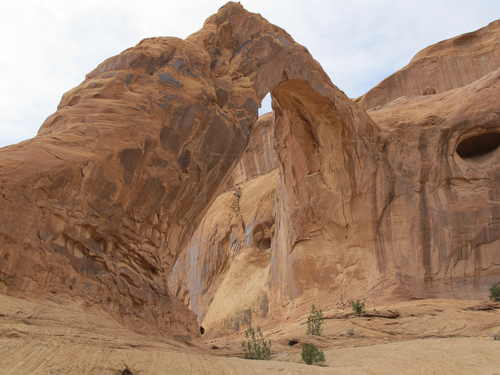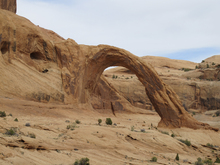This is an archived article that was published on sltrib.com in 2014, and information in the article may be outdated. It is provided only for personal research purposes and may not be reprinted.
Now that Corona Arch is in federal hands, the Bureau of Land Management has begun exploring whether to put an end to swinging and other high-thrill roped activities from the famous sandstone feature near Moab.
The arch, a 1.5-mile hike off the Colorado River, was a small but crucial piece of a massive land exchange completed May 8. In the deal involving 60,000 acres, the BLM traded lands with energy potential in the Uinta Basin for state-owned sections with scenic, recreational and natural values in Grand County.
"We have gotten complaints from those who go up to enjoy the quiet. Is it too much to ask? It's the noise that accompanies that activity that's a problem," said Katie Stevens, a recreation planner in BLM's Moab field office. "We haven't made a decision yet."
A viral YouTube video helped make Corona a rope-swinging destination in 2012. The state soon banned commercially guided swinging there, fearing liability would fall on the state School and Institutional Trust Lands Administration (SITLA) in the event of an accident.
Then, in March 2013, a young man with a do-it-yourself group fell to his death after jumping with a rope that was too long. And last month, just four days before the transfer was completed, another young man repeated the mistake that killed Kyle Stocking of West Jordan.
The 25-year-old New Yorker, Jack Davidson, was flown to a Colorado hospital with critical head injuries, according to the Grand County Sheriff's Office. He has since been transferred to a long-term-care facility.
"That's unfortunate," said John Andrews, SITLA's general counsel when informed of the more recent accident. He noted SITLA had posted an explicit warning sign at the BLM trailhead, informing visitors that they swing at their own peril.
"Corona Arch is over 100 feet high with sheer drops all around," the warning states. "There is high potential for serious injury or death even if your equipment works."
Davidson, who was not wearing a helmet, had completed five swings on May 4, according to sheriff's Lt. Kim Neal. But on his last swing of the day he attached the swing rope to an anchor swing parties use to pull the rope back to the top of the arch. This anchor is about 20 feet below the one Davidson should have used, which left him with too much slack in the rope, Neal said. Instead of swinging through the arch, he struck rock after falling 70 feet.
Despite the accidents, including recent falls at other arches in Grand County, swinging has persisted at Corona, judging from the complaints that come into the BLM, according to Stevens.
Many visitors believe swinging is an inappropriate activity that degrades others' experiences of the majestic formation, which wind and rain sculpted over thousands of years from the sandstone domes.
The Corona section traded into federal control includes the smaller Bowtie Arch. The BLM has started an environmental assessment to study the impacts of restricting roped activities in the area, as well as at a 10-acre area around Gemini Bridges. This twin bridge formation is on the rim of Bull Canyon between State Route 313 and U.S. Highway 191.
Banned activities would include swinging, rappelling, zip-lining, slacklining, and high-lining. The latter two refer to walking on a taut rope between two points, sometimes across a chasm, while a zipliner rides such ropes fixed at a descending angle.
If approved, the restrictions would be in place for two years while the BLM considers permanent bans, according to Jeffrey "Rock" Smith, a BLM supervisor in the Moab field office.


